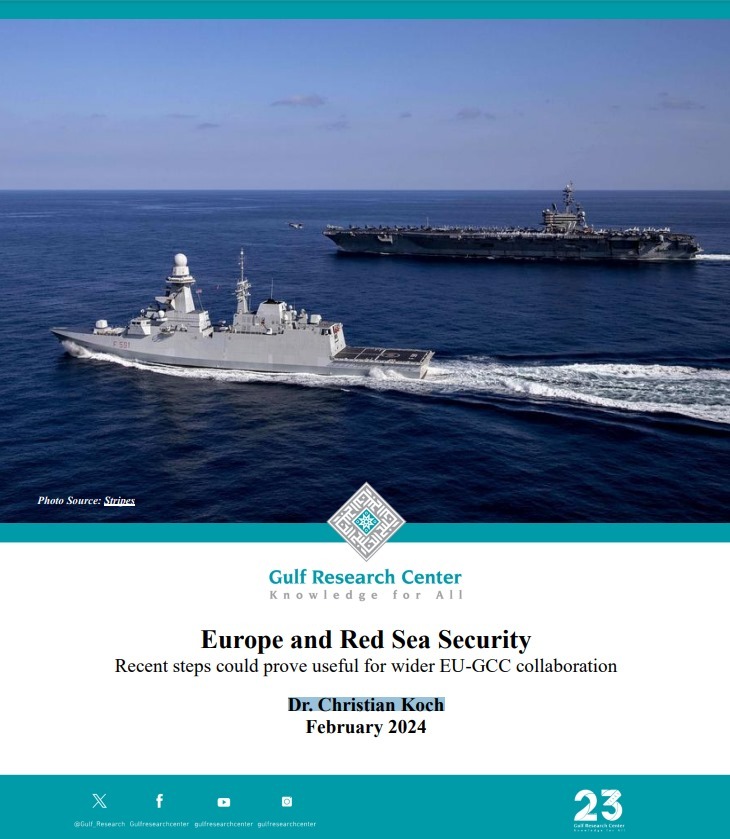Recent steps could prove useful for wider EU-GCC collaboration

The 27 EU member states are set to approve plans for a military mission to protect merchant shipping in the Red Sea when EU foreign ministers give their final seal of approval to the decision at a meeting in Brussels on February 19. Referred to as Operation Aspides, the mission involves deploying European warships and airborne early warning systems to protect cargo ships in the Red Sea, the Gulf of Aden, and surrounding waters.
The decision is a direct response to the increased attacks against commercial shipping by the Houthi group in Yemen. Since November 19, 2023, more than 30 ships have come under Houthi drone and missile strikes, as well as hijacking attempts in the area around the Bab el-Mandab. In response, the United States and the United Kingdom have launched multiple missile launches against the Houthi position in Yemen, prompting Houthi leader Abdul Malik al-Houthi to vow to continue with further escalated attacks.
Maritime security has become a priority item for the European Union. In addition to the Northwest Indian Ocean already being identified as an area of strategic interest by Brussels, Europe has now also classified the Red Sea as being of critical concern after the recent heightened tension there. In the wake of Russia’s invasion of Ukraine, Europe is also eager to widen its energy relationships with the Gulf region which necessitates the safety of maritime passages, especially as 40% of the EU’s trade with the Middle East and Asia passes through the Red Sea.
Operation Aspides follows numerous other naval missions that Europe already has in place in waters surrounding the Arabian Peninsula. Operation Atalanta was launched in 2008 to prevent and combat acts of piracy in the Indian Ocean. It is the first naval operation that the EU launched, and it cooperates with the multinational Combined Task Force 151 of the US-led Combined Maritime Forces (CMF) and NATO's anti-piracy Operation Ocean Shield. In December 2022, the mandate for Atalanta was extended for another 2 years until the end of 2024.
The European mission Maritime Awareness for the Strait of Hormuz (EMASoH), and its military arm Operation Agenor was launched on January 20, 2020, by a joint European declaration of support, becoming fully operational on February 25, 2020. Belgium, Denmark, France, Germany, Greece, Italy, the Netherlands, Norway, and Portugal are currently taking part in EMASoH. Similar to the new Operation Aspides, EMASoH aims to ensure a safe navigation environment, contribute to de-escalation of tensions, and facilitate an inclusive, regional dialogue in the Strait of Hormuz.
What is important to understand is that EMASoH and the pending Operation Aspides are not EUled missions but instead collaborative efforts by European states. In this manner, the EU, similar to NATO, can circumvent the unanimity principle that would require all member states to have to approve such missions before ships can be deployed. Operation Aspides has been pushed forward by the governments of Germany, Italy, France, and Denmark, with other European states likely to join the effort. The German frigate "Hessen" already left its home port of Wilhelmshaven on February 8 to take part in the mission with 250 soldiers on board.
The European approach differs from that of the United States in that it seeks to enhance cooperation with like-minded partners and regional as well as international organizations to promote dialogue, share best practices, and uphold rules-based order at sea. The main objective is to provide surveillance capabilities and the mission itself does not take sides with any power against another. The EU’s High Representative for Foreign and Security Policy Josep Borrell underlined that the mission will be "purely defensive," and will not conduct “any kind of attack.”
In line with the parameters of the European effort, European countries have also distanced themselves from the US-led Operation Prosperity Guardian as well as from the US and UK strikes on Houthi installations in Yemen. Similar to the position of the GCC states, Europe fears that such actions and direct confrontation will lead to greater escalation in the region, thus widening the conflict. Instead, Europe, through its operation, wants to allow some de-escalatory space with an emphasis on the protection of shipping and keeping sea lanes open as much as possible.
Given its emphasis on deconfliction, Operation Aspides could become a platform for building trust and confidence with the GCC and other Arab states. As outlined by European officials, the objective here is to seek to avoid any confrontational stance vis-à-vis Iran, something the GCC states are also keen to pursue. The emphasis therefore is on maritime diplomacy first and foremost. The Italian Minister of Defense, Guido Crosetto has already voiced his aspiration that: “Aspides will be an operation that we hope will also include the participation of moderate Arab countries who wish to join this collective security effort.” This would also be in line with the recent first EU-GCC security dialogue held in Riyadh on January 24 in which the two sides also discussed the issue of maritime security.
The issue of Red Sea security underlines the common assessment and approaches that the GCC states and the EU states have on the issue. This also applies to many of the other conflict situations in the Middle East region including the ongoing conflict in Gaza. Here, the EU and the Arab states are working together in the Peace Day effort to lay the framework for a revised peace process leading to an independent Palestinian state.
In line with the EU’s Strategic Partnership approach to the Gulf region, Europe is intensifying its overall efforts to contribute to conflict resolution mechanisms in the Middle East. Operation Aspides is another key element in this developing approach.
*Dr. Christian Koch is Director of Research at the Gulf Research Center

